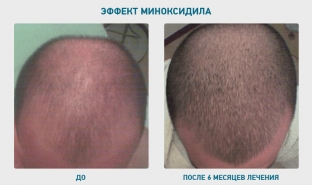One of the most common diseases in trichology is androgenetic alopecia – a genetic disease in which an increased content of male sex hormones in the blood provokes hair loss. It is currently difficult to find a trichologist who has never heard of the use of minoxidil – the most effective topical drug for the treatment of androgenetic alopecia. Today at estet-portal.com read how and why minoxidil has evolved from a gastric ulcer treatment to the most effective treatment for androgenetic alopecia.
Using Minoxidil – effective treatment for alopecia
The drug Minoxidil was first introduced in the 1950s as a drug for the treatment of stomach ulcers. As you know, the effectiveness of drug research in those days was not very good, and therefore only after some time it became clear that the drug does not cure ulcers, but is effective as a vasodilator. It was as such a drug that minoxidil was registered in 1979 by the American Food and Drug Administration.
A little later, American scientist Charles Chidsay conducted two studies and found out that the use of minoxidil has a side effect in the form of hair growth.
In 1988, minoxidil was approved for treatment of male pattern baldness, and in 1991 – as a treatment for androgenetic alopecia in women.
Minoxidil use:
- minoxidil use in alopecia: mechanism of drug action;
- how do different parts of the scalp react to minoxidil application;
- Efficacy of minoxidil compared to other hair growth stimulants.
Use of minoxidil in alopecia: mechanism of action of the drug
Despite the fact that the use of minoxidil for the treatment of alopecia has been practiced for more than 30 years, the reliable mechanism of action of the drug on hair follicles is currently unknown. However, scientists have been able to figure out the following main actions of minoxidil:
- stimulation of the COX2 enzyme, which increases the amount of prostaglandin PGE2;
- ability to penetrate transdermally;
- opening calcium channels and increasing the amount of calcium ions in cells, thereby affecting the expression of the VEGF gene;
- increase in viability and stimulation of hair papilla cell proliferation;
- decrease in the likelihood of apoptosis;
- proliferation of keratinocytes;
- opening of ATP-dependent potassium channels.
How different parts of the scalp react to minoxidil application
Different parts of the scalp in different ways respond to minoxidil. No topical agent has been shown to be effective in the fronto-temporal zone, but minoxidil has been shown to be clinically effective in the scalp vertex zone. This is explained by different molecular profiles of the follicles of the frontal and vertex zones. However, it has been proven that the hair follicles of these areas respond equally to minoxidil by a sharp increase in the expression of keratin-associated protein genes. A 2015 placebo-controlled study demonstrated an increase in the number and density of terminal hairs in both the frontal and vertex regions. Thus, minoxidil significantly increases the density of terminal hair on the forehead within 24 weeks of using the drug, which is comparable to its effectiveness for the parietal zone.<

Current use of Minoxidil – is not the only treatment option for alopecia, as there are other growth promoters. However, experimental comparisons have shown that:
- minoxidil – it is the only drug for the treatment of baldness with high efficacy proven by numerous studies;
- during the 30 years of the drug's existence, not a single full-fledged study has been conducted to compare the effectiveness of minoxidil with other hair growth stimulants;
- minoxidil – the only drug with direct clinical indications for the treatment of androgenetic alopecia;
- Minoxidil's complex mechanism of action includes the effects of most stimulants.
Using Minoxidil – this is the most effective method of conservative treatment of androgenetic alopecia, which has been repeatedly proven by numerous studies.Using 2% minoxidil increases hair growth by 8%, and a 5% - by 10-20%. Thank you for staying with estet-portal.com, more articles about
alopecia read in the Trichology section.







Add a comment